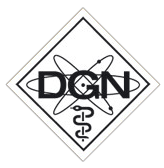
Abstracts der 57. DGN-Jahrestagung 2019
| Leuchtturm-Sitzung 2: Radiomics Vorsitz: R. A. Bundschuh, L. Papp 14:00 - 15:30 Kaisen-Saal |
|
| L6 Combined FET PET/MRI radiomics differentiates radiation injury from recurrent brain metastasis P. Lohmann1, M. Kocher1, G. Ceccon2, E. K. Bauer2, G. Stoffels1, S. Viswanathan1, M. I. Ruge3, B. Neumaier1, N. J. Shah1, G. R. Fink2, K. Langen1, N. Galldiks2 1Forschungszentrum Jülich, Institute of Neuroscience and Medicine, Jülich; 2University of Cologne, Dept. of Neurology, Cologne; 3University of Cologne, Dept. of Stereotaxy and Functional Neurosurgery, Cologne | |
|
Ziel/Aim: The aim of this study was to investigate the potential of combined textural feature analysis of contrast-enhanced MRI (CE-MRI) and static O-(2-[F-18]fluoroethyl)-L-tyrosine (FET) PET for the differentiation between local recurrent brain metastasis and radiation injury since CE-MRI often remains inconclusive.Methodik/Methods: Fifty-two patients with new or progressive contrast-enhancing brain lesions on MRI after radiotherapy (predominantly stereotactic radiosurgery) of brain metastases were additionally investigated using FET PET. Based on histology (n = 19) or clinicoradiological follow-up (n = 33), local recurrent brain metastases were diagnosed in 21 patients (40%) and radiation injury in 31 patients (60%). Forty-two textural features were calculated on both unfiltered and filtered CE-MRI and summed FET PET images (20 - 40 min p.i.), using the software LIFEx. After feature selection, logistic regression models using a maximum of five features to avoid overfitting were calculated for each imaging modality separately and for the combined FET PET/MRI features. The resulting models were validated using cross-validation. Diagnostic accuracies were calculated for each imaging modality separately as well as for the combined model.Ergebnisse/Results: For the differentiation between radiation injury and recurrence of brain metastasis, textural features extracted from CE-MRI had a diagnostic accuracy of 81% (sensitivity, 67%; specificity, 90%). FET PET textural features revealed a slightly higher diagnostic accuracy of 83% (sensitivity, 88%; specificity, 75%). However, the highest diagnostic accuracy was obtained when combining CE-MRI and FET PET features (accuracy, 89%; sensitivity, 85%; specificity, 96%).Schlussfolgerungen/Conclusions: Our findings suggest that combined FET PET/MRI radiomics using textural feature analysis offers a great potential to contribute significantly to the management of patients with brain metastases. | |


